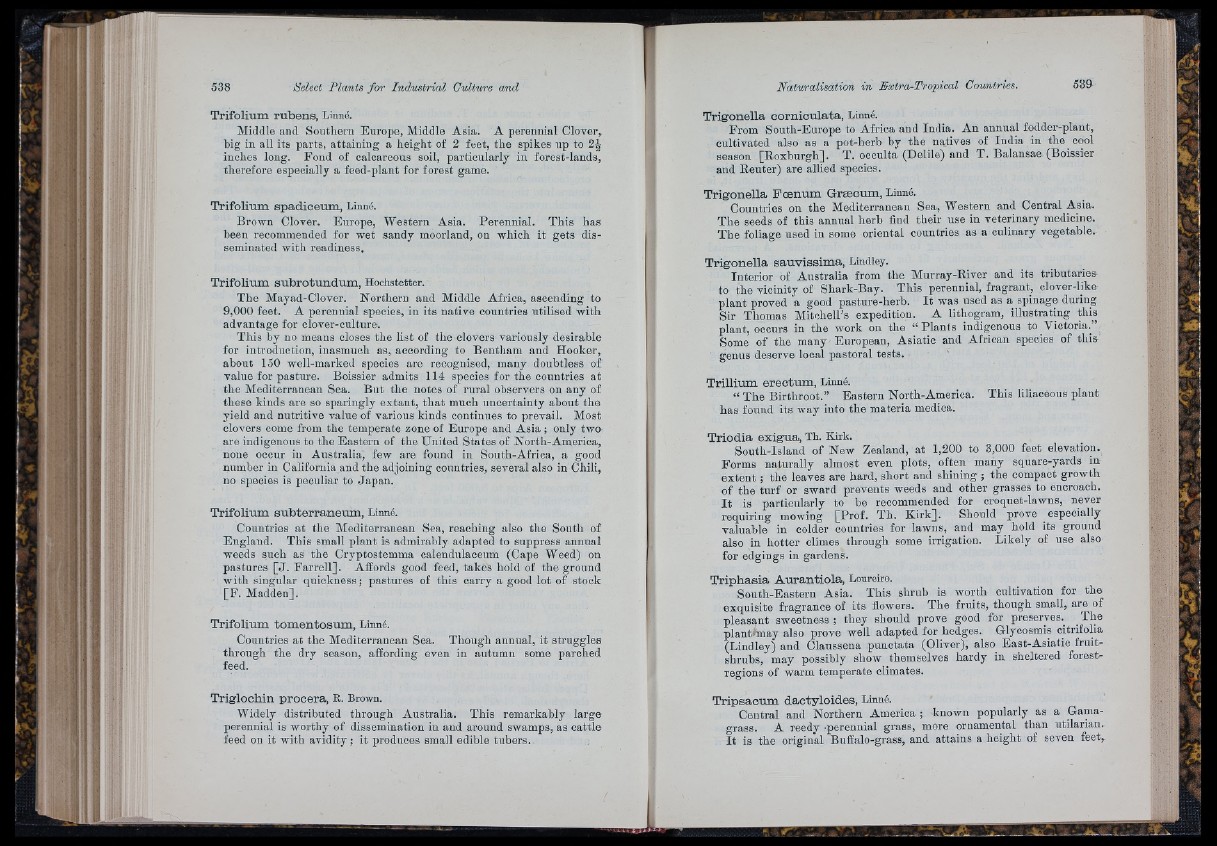
Trifolium rubens, Linné.
Middle and Southern Europe, Middle Asia. A perennial Clover,,
big in all its parts, attaining a height of 2 feet, the spikes up to 24
inches long. Fond of calcareous soil, partioularly in forest-lands,
therefore especially a feed-plant for forest game.
Trifolium spadioeum, Linné.
Brown Clover. Europe, Western Asia. Perennial. This has
been recommended for wet sandy moorland, on which it gets disseminated
with readiness.
Trifolium subrotundmn, Hochstetter.
The Mayad-Clover. Northern and Middle Africa, ascending to
9,000 feet. A perennial species, in its native countries utilised with
advantage for clover-cultnre.
This by no means closes the list of the clovers variously desirable
for introduction, inasmuch as, according to Bentham and Hooker,
about 150 well-marked species are recognised, many doubtless of
value for pasture. Boissier admits 114 species for the countries at
the Mediterranean Sea. But the notes of rural observers on any of
these kinds are so sparingly e.xtant, th a t much uncertainty about the
yield and nutritive valne of various kinds continues to prevail. Most
clovers come from the temperate zone of Europe and Asia ; only two
are indigenous to the Eastern of the United States of North-America,
none occur in Australia, few are found in South-Africa, a good
number in California and the adjoining conntries, several also in Chili,
no species is peculiar to Japan.
Trifolium subterraneum, Linné.
Conntries at the Mediterranean Sea, reaching also the South of
England. This small plant is admirably adapted to suppress annual
weeds such as the Cryptostemma calendulaeenm (Cape Weed) on
pastures [ J . Farrell]. Affords good feed, takes hold of the ground
with singular quickness ; pastures of this carry a good lot of stock
[F . Madden].
Trifolium tomentosum, Linné.
Countries a t the Mediterranean Sea. Though annual, it struggles
throngh the dry season, affording even in autumn some parched
feed.
Trigloohin prooera, R. Brown.
Widely distributed through Australia. This remarkably large
perennial is worthy of dissemination in and around swamps, as cattle
feed ou it with avidity; it produces small edible tubers.
Trigonella corniculata, Linné.
From South-Europe to Africa and India. An annual fodder-plant,
cultivated also as a pot-herb by the natives of India in the cool
season [Roxburgh]. T. occulta (Delile) and T. Balansae (Boissier
and Reuter) are allied species.
Trigonella Pcenum Græcum, Linné.
Countries on the Mediterranean Sea, Western and Central Asia.
The seeds of this annual herb find their use in veterinary medicine.
The foliage used in some oriental countries as a culinary vegetable.
Trigonella sauvissima, Lindley.
Interior of Australia from the Murray-River and its tributaries
to the vicinity of Shark-Bay. This perennial, fragrant, clover-ljke
plant proved a good pasture-herh. I t was used as a spinage during
Sir Thomas Mitchell’s expedition. A lithogram, illustrating this
plant, occurs in the work on the “ Plants indigenous to Victoria.”
Some of the many European, Asiatic and African species of th is
genus deserve local pastoral tests.
Trillium erectum, Linné.
“ The Birthroot.” Eastern North-America. This liliaceous plant
has found its way into the materia medica.
Triodia exigua, Th. Kirk.
South-Island of New Zealand, a t 1,200 to 3,000 feet elevation.
Forms naturally almost even plots, often many square-yards in
extent ; the leaves are hard, short and shining ; the compact growth
of the tu rf or sward prevents weeds and other grasses to encroach.
I t is particularly to be recommended for croquet-lawns, never
requiring mowing [Prof. Th. K irk ]. Should prove especially
valuable in colder countries for lawns, and may hold its ground
also in hotter climes through some irrigation. Likely of nse also
for edgings in gardens.
Triphasia Aurantiola, Loureiro.
South-Eastern Asia. This shrub is worth cultivation for the
exquisite fragrance of its flowers. The fruits, though small, are of
pleasant sweetness ; they should prove good for preserves.^ _ The
plant-may also prove well adapted for hedges. Glycosmis citrifolia
(Lindley) and Claussena punctata (Oliver), also East-Asiatic fruit-
shruhs, may possibly show themselves hardy in sheltered forest-
regions of warm temperate climates.
Tripsacum dactyloides, Linné.
Central and Northern America ; known popularly as a Gama-
grass. A reedy 'perennial grass, more ornamental than ntilarian.
I t is the original Buffalo-grass, and attains a height of seven feet,